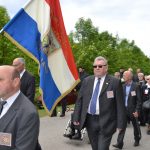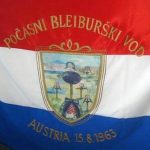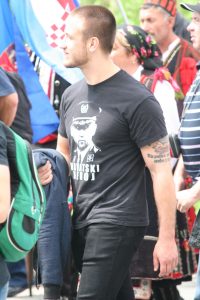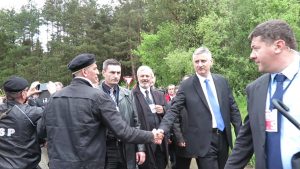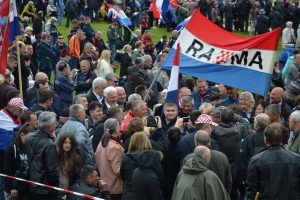The history of the extreme-rightwing association "Bleiburger Ehrenzug" (Počasni Bleiburški vod, PBV) and the development of the, by them organized, Ustaša meeting in Bleiburg / Pliberk are closely interwoven and were strongly influenced by Croatian and (ex-) Yugoslav domestic and foreign policy.
Modest beginnings
One year after the first "memorial service" on All Saints Day in 1952, the association was founded by former Ustaša and since 1955 regularly organizes the revisionist commemoration of the dead at the Loibach Field / Libuško polje (see Kolstø 2010). At the beginning of its activities in the 1950s, the "Ehrenzug" had a handful of members who had direct links to the NDH state until 1945 or were themselves in the ranks of the Ustaša. An example for this is the former Ustaša, founding member and longtime chairman, Ilija Abramović. In its early years, the “Ehrenzug” was also supported by the priest Vilim Cecelja, who after years alongside the Ustaša leader Ante Pavelić, settled down in Salzburg and actively supported the activities of extreme right-wing exile Croatians (see Posavski-Vremeplov 2016). Originally, the “commemoration ceremonies” at Loibach Field/Libuško polje were held around All Saints Day (November 1st) as well as in May. However, the event in May developed into the central celebration, although switching from Sunday to Saturday (see Kolstø 2010).
The activities of the "Ehrenzug" were a thorn in the flesh of socialist Yugoslavia. Especially in the 1970s, there were conflicts between the Yugoslav intelligence service (Uprava državne bezbednosti, UDBA) and the "Ehrenzug". Thus, in 1966 the UDBA placed a bomb in Bleiburg / Pliberk, which however went off too early. Also, the murder of a member of the “Bleiburger Ehrenzug”/PBV, Nikica Martinović, in Klagenfurt in 1975 is attributed to the UDBA and illustrates the scope of the conflict between the Yugoslav intelligence service (“Uprava državne bezbednosti”, UDBA) and right-wing extremist Croatian organizations which were active abroad (see Nielsen 2018).
Before the collapse of Yugoslavia, the meeting was limited to a few hundred visitors, most of them being exile-Croatians from Europe, Australia and North America. The “Ehrenzug” and the Ustaša meeting increased in importance only with the independence of Croatia in 1991 and the support of the nationalist and revisionist HDZ government under Franjo Tuđman. Since then, the glorification of individual war criminals or military organizations from the war in Yugoslavia and the showing of their symbols and flags are a regular part of the celebrations in addition to the display of symbols of the Ustaša / NDH state.
Allies in the political system …
Depending on the composition of the government, the Croatian parliament will henceforth grant patronage over the meeting and as well as financial support. Large cash flows, currently a six-digit figure in Euros, made not only the purchase of land at Loibach Field / Libuško Polje possible but also the building of new infrastructure, which in 2007 led to the construction of a stage (see Kolstø 2010). The course of the event is divided into several places until today. The annual celebration begins in the small cemetery in Unterloibach / Spodnje Libuče near Bleiburg / Pliberk with a Christian devotion. However, the vast majority of visitors gather directly at the monument, which is about two kilometers outside of Bleiburg / Pliberk. The participants march from the cemetery on the road to the monument. The public roads are closed off by the Austrian police throughout the day. During this march, flags and political banners are also carried. At the monument, the actual celebration begins with a Catholic mass and numerous speeches by right-wing and conservative Croatian politicians. Highlight is the wreath-laying at the monument. The celebration is officially declared by the organizer as a 'procession' in order to not have to adhere to legal standards usually applied to assemblies and events.
In the anniversary year 2015, the striking number of people of 30,000 gathered at the Loibach Field / Libuško polje to mourn the NDH state (Kleine Zeitung, 2015). For a number of years now, the formal part of the ceremony has also been broadcasted live in the Croatian public broadcasting service HRT. The event is by no means merely a place of networking of explicitly right-wing extremist associations and personalities. It is more than that: Serving mythological stories of suffering that bind citizens to the identities and experiences of the Ustaša regime allows an exchange of right-wing extremist and historical revisionist ideas that reach deep into the conservative political camp as well as the Croatian Catholic Church.
In this sense, the Croatian parliament under an HDZ majority contributes not only to the financing of the event, highest ranking political officials also attend it every year. In 2016, for example, the then Deputy Prime Minister Tomislav Karamarko (HDZ) and the controversial then Minister of Culture Zlatko Hasanbegović (HDZ) were present. Premier Ministers and even the current right-wing President Kolinda Grabar-Kitarović, on the other hand, often visit the memorial a few days before the ceremony and lay wreaths. The fear of compromising oneself seems too big to have oneself be associated with the event and its participants on an international stage. On the side of the church it was Želimir Puljić, the Archbishop of Zadar, who led the mass in 2018. This is the same cleric who three years earlier proposed a referendum on the reintroduction of the fascist greeting "Za dom spremni" (“Prepared for the homeland”) in the Croatian military (Novi List 2015).
… and the usual suspects
War criminals such as Dario Kordić are courted in this mix of prominent public figures. Kordić was a politician of the Bosnian-Herzegovinian HDZ, who was sentenced by the International Criminal Court in The Hague to 25 years in prison for crimes against humanity. His excellent relationships with, for example, Miroslav Piplica, chairman of the HDZ branch in Austria and co-organizer of various cultural events in Vienna, make him a welcome guest (Der Standard 2014). It goes without saying that the celebration in Loibach / Libuče is also used as a stage by officials of the neo-fascist HČSP party or the TV journalist Velimir Bujanec who very obviously shows which side he stands on. He outed himself during the civil wars of the 1990s as an open Ustaša supporter and has now, through the fame of his own TV talk show, turned into a member of the HDZ that maintains the best relations with top government officials (Balkan Insight 2016).
Right-wing extremist networking also takes place on an international scale in Loibach / Libuče: the FPÖ / FPK politicians Anneliese Kitzmüller, Austria's Third National Council President since 2017, as well as Josef Lobnig, the Third President of the Carinthian Parliament, were welcome guests of the "commemoration". While Croatian right-wing extremist Tomislav Sunić gave speeches at SS commemorations of the dead at Ulrichsberg/Šenturška gora, representatives of Carinthian far right extremism such as Willi Überfellner (Kärntner Abwehrkämpferbund) or Peter Mussi (Akademische Sängerschaft Tauriska zu Klagenfurt) visited the event in Bleiburg/Pliberk in 2017.
Applause comes from numerous sympathizers and religious believers, most of whom travel to the celebration from Croatia or from the Croatian diaspora.
References
Balkan Insight (2016): What were the Ustasa for Minister Hasanbegovic: http://www.balkaninsight.com/en/article/what-were-the-ustasa-for-minister-hasanbegovic--02-12-2016, accessed on 28.10.2018.
Der Standard (2014): Jubel für Kriegsverbrecher: https://derstandard.at/2000001868816/Jubel-fuer-Kriegsverbrecher, accessed on 28.10.2018.
Jutarnji (2014): EKSKLUZIVNO Evo dokaza da je hrvatskog emigranta 1975. godine ubila slovenska Udba: https://www.jutarnji.hr/vijesti/hrvatska/ekskluzivno-evo-dokaza-da-je-hrvatskog-emigranta-1975.-godine-ubila-slovenska-udba/847207/, accessed on 28.10.2018.
Kleine Zeitung (2015): 30.000 Kroaten am Loibacher Feld: https://www.kleinezeitung.at/kaernten/landespolitik/4732786/70-Jahrestag_30000-Kroaten-am-Loibacher-Feld, accessed on 28.10.2018.
Kolstø, Pål (2010): Bleiburg: The Creation of a National Martyrology. In: Europe-Asia Studies, Jg. 62, H. 7, 09/2010m S. 1153-1174, here p. 1159.
Novi List (2015): Crkva za referendum o ustaskom pozdravu “Za dom spremni”: http://www.novilist.hr/Vijesti/Hrvatska/Crkva-za-referendum-o-ustaskom-pozdravu-Za-dom-spremni, accessed on 28.10.2018.
Posvski-Vremeplov (2016): Pocasni bleiburski vod: https://www.posavski-vremeplov.com/suzna-dolina/po%C4%8Dasni-bleibur%C5%A1ki-vod/, accessed on 28.10.2018.
